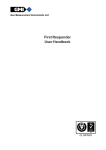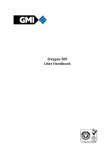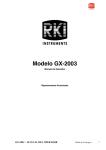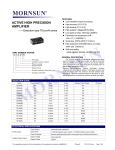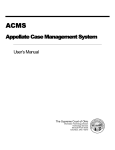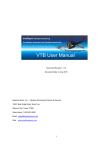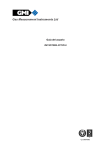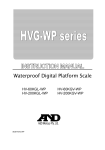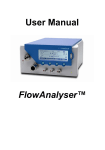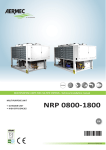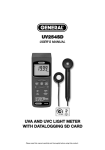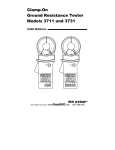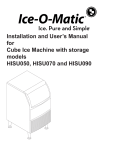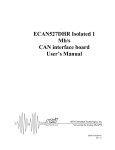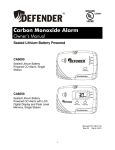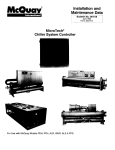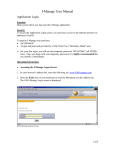Download User Manual PDF
Transcript
User Handbook 1 USER HANDBOOK Issue 2 30/05/06 Part Number: 67112 GMI welcomes comments on all our publications. Your comments can be of great value in helping us to improve our customer publications. Please send any comments that you have to our Sales Department at GMI. Contact details are provided inside the back cover of this handbook. Instrument Service / Repair contact details are also provided inside the back cover of this handbook. Copyright © Gas Measurement Instruments Ltd 2005 2 COPYRIGHT COPYRIGHT This User Handbook is copyright of Gas Measurement Instruments Ltd (GMI) and the information contained within, is for use only with GT series instruments. Reproduction, in whole or in part, including utilisation in machines capable of reproduction or retrieval without written permission of Gas Measurement Instruments Ltd is prohibited. Reverse engineering is not permitted. LIABILITY Every care has been taken in the preparation of this document, but GMI Ltd do not accept any responsibility for errors or omissions and their consequences. Information in this document is subject to change without notice. This document does not constitute a specification or basis for a contract. Your statutory rights under law are not affected. MODIFICATION NOTICES GMI aim to notify customers of relevant changes in the product operation and maintain this manual up to date. In view of the policy of continuous product improvement there may be operational differences between the latest product and this manual. This Handbook is an important part of the GT series product. Please note the following points: It should be kept with the instrument for the life of the product. Amendments should be attached. This Handbook should be passed on to any subsequent owner/user of the instrument. Although every care is taken in the preparation of this Handbook it does not constitute a specification for the instrument. SOFTWARE Software supplied on EPROM or similar device for use in a particular product, may only be used in that product and may not be copied without the written permission of Gas Measurement Instruments Ltd. Reproduction or disassembly of such embodied programmes or algorithms is prohibited. Ownership of such software is not transferable and GMI Ltd does not warrant that the operation of the software will be error free or that the software will meet the customers requirements. DISPOSAL ADVICE When no longer in use, dispose of the instrument carefully and with respect for the environment. GMI will dispose of the instrument without charge if returned to the factory. i USER HANDBOOK SAFETY The instrument must be regularly serviced and calibrated by fully trained personnel in a safe area. Batteries: Alkaline or *Rechargeable batteries must be exchanged (*and recharged) in a safe area and fitted correctly before use. Never use damaged batteries or expose to extreme heat. See Chapter 12 : OPERATOR MAINTENANCE. Only GMI replacement parts should be used. If the instrument detects gas, follow your own organisations procedures and operational guidelines. The combustion chamber is a flameproof assembly and must not be opened in the presence of a flammable atmosphere. GT series instruments are certified as ATEX II 2 G EEx iad IIB T3 (-20oC < Tamb < 50oC). UL Class 1 Groups C and D. This equipment is designed and manufactured to protect against other hazards as defined in paragraph 1.2.7 of Annex II of the ATEX Directive 94/9/EC Any right of claim relating to product liability or consequential damage to any third party against GMI is removed if the warnings are not observed. WARNING: To prevent ignition of flammable or combustible atmospheres, remove batteries before servicing. WARNING: To prevent ignition of flammable or combustible atmospheres, read, understand and adhere to the manufacturers live maintenance procedures. WARNING: To reduce the risk of ignition of a flammable or explosive atmosphere, batteries must be changed only in a location known to be non-hazardous. WARNING: To reduce the risk of explosion, do not mix old batteries with used batteries or mix batteries from different manufacturers. WARNING: Never attempt to recharge non rechargeable cells. CAUTION: Not for use in oxygen enriched atmospheres. CAUTION: Replace batteries only with approved batteries: NiMH GP350 Alkaline Duracell, Energizer, Rayovac. ii COPYRIGHT AREAS OF USE Exposure to certain chemicals can result in a loss of sensitivity of the flammable sensor. Where such environments are known or suspected it is recommended that more frequent response checks are carried out. The chemical compounds that can cause loss of sensitivity include Silicones, Lead, Halogens and Sulphur. Do not use instrument in potentially hazardous atmospheres containing greater than 21% Oxygen. The enclosure material is polypropylene and must not be exposed to environments which are liable to result in mechanical or thermal degradation or to damage caused by contact with aggressive substances. Additional protection may be required in environments where the instrument enclosure is liable to damage. STORAGE, HANDLING AND TRANSIT Rechargeable batteries contain considerable energy and care should be taken in their handling and disposal. Batteries should be removed if the instrument is stored for longer than 3 months. The instrument is designed to handle harsh environments. The sensing elements are sealed to IP54 and the rest of the instrument to IP64. If not subject to misuse or malicious damage, the instrument will provide many years of reliable service. The instrument contains electrochemical sensors with a life of 2 years. Under conditions of prolonged storage the sensors should be removed. The sensor contains potentially corrosive liquid and care should be taken when handling or disposing of the sensor, particularly when a leak is suspected. WARRANTY The GT series instrument has a warranty against faulty goods or workmanship of 5 years. Consumable and Mechanical parts are not included in this. These are covered under GMI standard warranty conditions. For details, please contact GMI Ltd (UK). iii USER HANDBOOK iv REVISION RECORD Date Issue Description Of Change 07/09/2005 1 New Handbook 30/05/2006 2 To incorporate effect of CR 4223, CR 4229, CR 4279 and various other instrument configuration updates. v USER HANDBOOK vi CONTENTS CONTENTS COPYRIGHT ................................................................... i LIABILITY ....................................................................... i MODIFICATION NOTICES ................................................ i SOFTWARE ................................................................... i DISPOSAL ADVICE ........................................................ i SAFETY ......................................................................... ii AREAS OF USE ............................................................ iii STORAGE, HANDLING AND TRANSIT ......................... iii WARRANTY ................................................................. iii REVISION RECORD ....................................... v INTRODUCTION .......................................... 1-1 1.1 INSTRUMENT RANGES .................................... 1-3 GENERAL FEATURES ............................... 2-1 2.2 MODES OF OPERATION ................................... 2-2 OPERATING PROCEDURE ........................ 3-1 3.1 SWITCH THE INSTRUMENT ON ........................ 3-2 3.2 INSTRUMENT IDENTIFICATION ......................... 3-3 vii USER HANDBOOK 3.3 BATTERY STATUS ........................................... 3-3 3.4 TIME AND DATE ................................................ 3-4 3.5 CALIBRATION DUE DATE ................................. 3-4 3.6 SERVICE DUE DATE ....................................... 3-10 3.7 SWITCH THE INSTRUMENT OFF OR RE-ENTER THE MODE MENU ................................................... 3-17 LEAK TEST MODE ..................................... 4-1 LEAK TEST RANGES .............................................. 4-1 4.2 LEAK TEST FEATURES .................................... 4-1 4.3 LEAK TEST DISPLAYS ..................................... 4-2 4.4 LEAK TEST BUTTON OPERATION ................... 4-6 4.5 DESCRIPTION OF LEAK TEST BUTTON OPERATION ......................................................................... 4-7 4.6 LEAK TEST TICKER (GEIGER) FUNCTION ..... 4-11 4.7 LEAK TEST ALARMS ..................................... 4-12 4.8 LEAK TEST LOGGING .................................... 4-12 CONFINED SPACE MODE ......................... 5-1 5.1 CSM RANGES .................................................. 5-1 5.2 CSM FEATURES ............................................... 5-1 5.3 CSM DISPLAYS ................................................ 5-2 5.4 CSM BUTTON OPERATION .............................. 5-4 5.5 DESCRIPTION OF CSM BUTTON OPERATION .. 5-5 5.6 CSM PUMP ........................................................ 5-8 5.7 CSM ALARMS .................................................. 5-8 viii CONTENTS 5.8 CSM LOGGING ................................................. 5-8 5.9 CSM CONFIDENCE SIGNAL ............................. 5-9 BARHOLE TESTING MODE ....................... 6-1 6.1 BARHOLE RANGES ......................................... 6-1 6.2 BARHOLE FEATURES ...................................... 6-1 6.3 BARHOLE DISPLAYS ....................................... 6-2 6.4 VIEW BARHOLE RESULTS .............................. 6-8 6.5 BARHOLE OPERATION .................................. 6-10 6.6 DESCRIPTION OF BARHOLE BUTTON OPERATION ....................................................................... 6-10 6.7 BARHOLE ALARMS ....................................... 6-12 CO (CARBON MONOXIDE) MODE ............. 7-1 7.1 CO RANGES ..................................................... 7-1 7.2 CO FEATURES .................................................. 7-1 7.3 CO MENU .......................................................... 7-2 7.4 CO DISPLAYS .................................................. 7-3 7.5 CO BUTTON OPERATION ................................. 7-6 7.6 DESCRIPTION OF CO BUTTON OPERATION .... 7-6 7.7 CO ALARMS ..................................................... 7-8 7.8 CO LOGGING ................................................... 7-8 PURGE MODE ........................................... 8-1 8.1 PURGE RANGES .............................................. 8-1 ix USER HANDBOOK 8.2 PURGE FEATURES ........................................... 8-1 8.3 PURGE DISPLAYS ............................................ 8-2 8.4 PURGE BUTTON OPERATION .......................... 8-3 8.5 DESCRIPTION OF PURGE BUTTON OPERATION .. ................................................................................. 8-4 8.6 PURGE ALARMS .............................................. 8-5 SNIFFER MODE ......................................... 9-1 9.1 SNIFFER RANGES ............................................ 9-1 9.2 SNIFFER FEATURES ......................................... 9-1 9.3 SNIFFER DISPLAYS ......................................... 9-1 9.4 SNIFFER BUTTON OPERATION ........................ 9-3 9.5 DESCRIPTION OF SNIFFER BUTTON OPERATION ................................................................................. 9-3 9.6 SNIFFER TICKER (GEIGER) INDICATION .......... 9-6 PRESSURE MODE .................................. 10-1 10.1 PRESSURE RANGES .................................... 10-1 10.2 PRESSURE FEATURES ................................. 10-1 10.3 PRESSURE DISPLAYS ................................ 10-2 10.4 PREPARE INSTRUMENT (PRESSURE MODE)10-3 10.5 PRESSURE BUTTON OPERATION ................ 10-4 10.6 DESCRIPTION OF PRESSURE BUTTON OPERATION ....................................................................... 10-4 10.7 PRESSURE ALARMS .................................... 10-5 x CONTENTS ALARMS .................................................... 11-1 11.1 GAS ALARMS .............................................. 11-1 11.2 FLAMMABLE (LEL) ALARMS ....................... 11-1 11.3 OXYGEN (O2) ALARMS ............................... 11-1 11.4 TOXIC GAS (e.g. CO) ALARMS ................... 11-1 11.5 ALARM TYPES ............................................. 11-9 11.6 FAULT ALARMS ......................................... 11-13 OPERATOR MAINTENANCE .................... 12-1 12.1 CLEANING .................................................... 12-1 12.2 FILTER REPLACEMENT ................................ 12-1 12.2.1 Probe Filter ................................................ 12-2 12.2.2 Chemical Filter (Accessory) .................... 12-5 12.2.3 Cotton Filter (Accessory) ...................... 12-10 12.3 BATTERY REPLACEMENT ........................ 12-13 12.3.1 Remove and Replace Batteries ............. 12-15 12.3.2 Charging (Rechargeable) Batteries ....... 12-19 CALIBRATION ........................................... 13-1 13.1 CALIBRATION VALIDITY .............................. 13-2 ACCESSORIES ........................................ 14-1 xi USER HANDBOOK ADDITIONAL INFORMATION ..................... 15-1 Training .................................................................... 15-1 World Wide Web ...................................................... 15-1 TYPICAL OPERATING PARAMETERS ....... A-1 Dimensions (excl. probe) ....................................... A-2 Weight (incl. probe & batteries) ............................. A-2 Temperature Limits ................................................. A-2 Humidity .................................................................. A-2 Construction / Protection Rating ............................ A-2 Display .................................................................... A-2 Sampling System .................................................... A-2 Power Source ........................................................ A-2 INDEX ............................................................. I xii INTRODUCTION 1 INTRODUCTION The GMI GT series instruments are designed to be multifunction, multi-application gas detectors to suit all the needs of a Gas Industry Service Technician. Fig. 1.1 GT series Instrument 1-1 USER HANDBOOK In the following procedure, the five instrument buttons shown in Fig 1.2 are referred to as detailed below: Centre LH Up RH Down Fig. 1.2 Button References Button Text Reference LH (INVERT): LH button Centre (RANGE): Centre button RH (PUMP): RH button Up: UP button Down: DOWN button 1-2 INTRODUCTION The bottom line of the instrument display may indicate button press options. For example, to select Yes from the following screen option, you would press the RH button. To select No, the LH button would be pressed. Fig 1.3 Option Select The principle of selecting any one of three options on the bottom line of the instrument display, by pressing either LH, CENTRE or RH buttons, is used throughout the operation of this instrument. 1.1 INSTRUMENT RANGES The detection ranges, available but which may not all be included in the version of GT selected by your company, are: 0-10,000 ppm Flammable (Sniffer Range) 0-100% VOL Flammable 0-100% LEL Flammable (Option to display as %Gas) 0-25% O2 0-2000 PPM CO 0-100 PPM H2S 0 to 60 in. Water Gauge (0 to 150mBar) 1-3 C01.pmd 3 22/06/2006, 11:02 USER HANDBOOK 1-4 GENERAL FEATURES 2 GENERAL FEATURES An integral pump draws the required sample over all of the sensors The pump flow is monitored by means of a pressure transducer Datalogging is available for some applications A Bleep sounds for each button press A green LED indicates Power ON To simplify use in its many applications, the instrument utilises a menu system similar to a (cell) mobile phone, as shown in Fig 2.1. Fig. 2.1 Mode Menu The bottom line of the LCD can also be used to indicate press and hold button functions available. 2-1 USER HANDBOOK By simple selection of the application you need, the appropriate gas(es) are shown on the display and only the necessary button functions and alarms are activated. Note: Your company may have decided to have its instruments configured only for certain of the aforementioned applications. 2.2 MODES OF OPERATION Leak Test This mode is for the technician to investigate odour or leak complaints and to pinpoint the leak. Refer to Chapter 4 for Leak Test mode operation. Confined Space Used for confined space pre-entry testing and for personal monitoring in areas such as basements etc. Refer to Chapter 5 for Confined Space mode operation. Barhole Used to locate underground leaks. This can be timed or non-timed. Your company may have selected only one of these options. Refer to Chapter 6 for Barhole mode operation. CO The CO (Carbon Monoxide) mode allows the user to make either CO Direct, Differential CO, or Air Free CO readings (if an O2 cell is fitted). Note: Your company may have chosen only certain of these options. Refer to Chapter 7 for CO mode operation. 2-2 GENERAL FEATURES Purge This mode is used in gas and air purging applications. Refer to Chapter 8 for Purge mode operation. Sniffer This mode is used to find small fitting leaks. Very fast detection rates are achieved using the semiconductor sensor in the probe. Refer to Chapter 9 for Sniffer mode operation. Pressure In this mode, the instrument can be used as a manometer to measure appliance and regulator pressure and to check the system for leaks. Refer to Chapter 10 for Pressure mode operation. 2-3 USER HANDBOOK 2-4 OPERATING PROCEDURE 3 OPERATING PROCEDURE Check the following: The instrument is clean and in good condition. The batteries are in good condition, fully charged and fitted correctly. The hydrophobic filter is clean and in good condition. The sample line and any other accessories used are in good condition. The clear bulb at probe end is screwed tightly. Switch instrument ON in fresh air. The battery indication provides sufficient capacity for the operation. The instrument is within the calibration period you have decided is necessary for your application. All applicable ranges are operational. There are no fault indications. Attach optional accessories, as required. The instrument displays a sample / flow fault when inlet is blocked (with a finger for example). If fault is not displayed, check tightness of all fittings. After use, allow the instrument to run for 1 2 minutes in fresh air before switching the instrument OFF. 3-1 USER HANDBOOK Each time you use the instrument, carry out the following procedure: 3.1 SWITCH THE INSTRUMENT ON To switch the instrument ON in fresh air: Press and hold the RH button , for one second. Fig. 3.1 Switch ON The instrument begins its warm-up routine, which lasts approximately 30 seconds. During the warm-up cycle, a countdown timer appears in the top right hand corner of the display. The Power ON LED illuminates when the instrument is switched ON and also during operation. The display backlight illuminates and remains ON during warm-up. When the warm-up cycle is complete, the screen light automatically switches OFF. The Fault LED illuminates briefly, for approximately five (5) seconds, during the warm-up cycle. 3-2 OPERATING PROCEDURE 3.2 INSTRUMENT IDENTIFICATION During the warm-up cycle, the instrument display identifies the model, serial number, software version and battery status information as shown in Fig. 3.2: Fig. 3.2 Instrument Identification 3.3 BATTERY STATUS This feature provides the user with a battery capacity level indicator that displays instrument battery power remaining, as shown in Fig. 3.3. 100% 75% 50% 25% Fig. 3.3 Battery Capacity This battery symbol will be indicated for approximately five (5) seconds during the warm-up cycle, then on the top of the display during normal operation. 3-3 USER HANDBOOK 3.4 TIME AND DATE The time and date from the instruments built-in clock is displayed on the screen during warm-up, as shown in Fig. 3.4. If datalogging is being used, the time and date is set from this clock. This may be important when viewing the logged data. Fig. 3.4 Time and Date 3.5 CALIBRATION DUE DATE The CAL DUE date can be set by the workshop and is set to 365 days by default. The date can be set from 1 to 400 days. The CAL DUE is reset when the instrument is successfully calibrated. The CAL DUE feature has five (5) configurable options: 1. Cal Due Date message is not displayed. 3-4 OPERATING PROCEDURE 2. Cal Due Date and overdue date messages are displayed. Calibration due date is displayed, as shown in Fig. 3.5. Fig. 3.5 Calibration Due Date The screen, shown in Fig. 3.6, is displayed when the Calibration date has expired. i.e. overdue. Fig. 3.6 Calibration Overdue After approximately five (5) seconds, the instrument warm-up continues. 3-5 USER HANDBOOK 3. Cal Due Date message is displayed with user acknowledge if overdue (Default). Calibration due date is displayed as shown in Fig. 3.7. Fig. 3.7 Calibration Due Date The screen, shown in Fig. 3.8, is displayed when the Calibration date has expired. i.e. overdue. Fig. 3.8 Calibration Overdue The user must acknowledge that Calibration has expired. To continue: Press and hold YES to continue. 3-6 for instrument warm-up OPERATING PROCEDURE To switch OFF: Press and hold NO . The screen, shown in Fig. 3.9, is displayed. Fig. 3.9 Switch OFF Press and hold both the LH button button and the RH simultaneously to proceed with the switch-off sequence. 4. Cal Due Date message is displayed with user acknowledge for extended period option, if overdue. Calibration Due Date message is displayed, as shown in Fig. 3.10. Fig. 3.10 Calibration Due Date 3-7 USER HANDBOOK If overdue but within the extended period, the screen, shown in Fig. 3.11, is displayed. Fig. 3.11 Calibration Overdue The user must acknowledge that Calibration has expired. Note: The extended period can be set from 1 to 31 days To accept extended period option: Press and hold YES and the instrument warm- up continues. Note: When the extended period option expires, the user will be forced to switch the instrument OFF. To reject extended period option: Press and hold NO Fig. 3.12, is displayed. 3-8 . The screen, shown in OPERATING PROCEDURE Fig. 3.12 Switch OFF Press and hold both the LH button button and the RH simultaneously to proceed with the switch-off sequence. 5. Cal Due Date message is displayed with user shut-down if overdue. Calibration due date is displayed, as shown in Fig. 3.13. Fig. 3.13 Calibration Due Date The screen, shown in Fig. 3.14, is displayed when the Calibration date has expired. i.e. overdue. 3-9 USER HANDBOOK Fig. 3.14 Switch OFF To proceed with the switch-off sequence. Press and hold both the LH button button and the RH simultaneously. 3.6 SERVICE DUE DATE The Service due date can be set by the workshop and is set to two (2) years by default from last service date. The date can be set over a period of 1 to 36 months in 1 month steps. Note : The service due date will not normally be displayed at start up but if display is selected, it will be shown at 90 days prior to the preset date, as shown in Fig. 3.15. The SERVICE DUE feature has five (5) configurable options: 1. Service Due Date message is not displayed (Default). 3-10 OPERATING PROCEDURE 2. Service Due Date and overdue date messages are displayed, as shown in Fig. 3.15. Fig. 3.15 Service Due Date The screen, shown in Fig. 3.16, is displayed when the Service date has expired. i.e. overdue. Fig. 3.16 Service Overdue After approximately five (5) seconds, the instrument warm-up continues. 3-11 USER HANDBOOK 3. Service Due Date message is displayed with user acknowledge if overdue. Service due date is displayed, as shown in Fig. 3.17. Fig. 3.17 Service Due Date The screen, shown in Fig. 3.18, is displayed when the Service date has expired. i.e. overdue. Fig. 3.18 Service Overdue The user must acknowledge that Service has expired. To continue: Press and hold YES to continue. 3-12 for instrument warm-up OPERATING PROCEDURE To switch OFF: Press and hold NO . The screen, shown in Fig. 3.19, is displayed. Fig. 3.19 Switch OFF Press and hold both the LH button button and the RH simultaneously to proceed with the switch-off sequence. 4. Service Due Date message is displayed with user acknowledge for extended period option, if overdue. Service Due Date message is displayed, as shown in Fig. 3.20. Fig. 3.20 Service Due Date 3-13 USER HANDBOOK If overdue but within the extended period, the screen, shown in Fig. 3.21, is displayed. Fig. 3.21 Service Overdue The user must acknowledge that Service has expired. Note: The extended period can be set from 1 to 31 days To accept extended period option: Press and hold YES and the instrument warm- up continues. Note: When the extended period option expires, the user will be forced to switch the instrument OFF. To reject extended period option: Press and hold NO Fig. 3.22, is displayed. 3-14 . The screen, shown in OPERATING PROCEDURE Fig. 3.22 Switch OFF Press and hold both the LH button button and the RH simultaneously to proceed with the switch-off sequence. 5. Service Due Date message is displayed with user shut-down if overdue. Service due date is displayed, as shown in Fig. 3.23. Fig. 3.23 Calibration Due Date 3-15 USER HANDBOOK The screen, shown in Fig. 3.24, is displayed when the Service date has expired. i.e. overdue. Fig. 3.24 Switch OFF To proceed with the switch-off sequence: Press and hold both the LH button button and the RH simultaneously. Warm-up Complete The instrument will now automatically select the Leak Test Mode, as default. The following configurable options are available: a) To start up in specific operational mode. b ) To start up in the mode last used. 3-16 OPERATING PROCEDURE 3.7 SWITCH THE INSTRUMENT OFF OR REENTER THE MODE MENU To initiate the shut down sequence: Press and hold both the LH and RH but- tons simultaneously. Fig. 3.25 Switch OFF While both buttons are depressed, the instrument display will step through previous menus, each displayed for approximately two (2) seconds. After this time, the OFF sequence countdown begins and the user will have to keep the buttons pressed for a further three (3) seconds to switch the instrument OFF. The countdown sequence is shown in Fig. 3.26. Note: In Confined Space Mode, to prevent inadvertently switching instrument OFF or changing mode while 3-17 USER HANDBOOK alarms are active, the user must press and hold both the LH and RH buttons simultaneously for an additional five (5) seconds before the mode menu appears. Fig. 3.26 OFF sequence The switching OFF sequence can be aborted at any time by releasing the held buttons which provides access to the Mode menu, shown in Fig. 3.27: Fig. 3.27 Mode Menu 3-18 OPERATING PROCEDURE To highlight the required option: Press the UP or DOWN buttons, then . . To select the highlighted option: Press and hold OK . 3-19 USER HANDBOOK 3-20 LEAK TEST MODE 4 LEAK TEST MODE This mode is for the technician to investigate odour or leak complaints and to pinpoint the leak. 4.1 LEAK TEST RANGES Leak Test mode will have the following ranges available for normal operation: 0 2000 ppm CH4 0 100% LEL (option to display as gas in air) 0 100% Vol Gas 0 2000 ppm CO (if fitted) 4.2 LEAK TEST FEATURES Leak Test mode will have the following features available: Audible / Visual PPM Ticker (Geiger) Indication (Option ON at switch-on) Audible / Visual Gas Alarms Backlight Flashlight Pump - can be toggled ON / OFF and will stop if flow fault is detected Max Display Autoranging from ppm-LEL-Gas 4-1 USER HANDBOOK Manual Range selection between Flam and Flam plus CO (Dual Display) Threshold adjustment Display Invert Automatic datalogging 4.3 LEAK TEST DISPLAYS During the warm-up period, all applicable sensors will be checked and the display, shown in Fig. 4.1, will indicate any sensor faults. alternating with Fig. 4.1 Sensor Check After the sensors have been checked, the normal display will be as shown in Fig. 4.2. 4-2 LEAK TEST MODE Fig. 4.2 Normal Display Example Note 1: Any faulty sensor will continue to display a spanner (wrench) symbol alternating with the gas reading and the fault LED will illuminate. Note 2: Continuous display of both flammable and CO is a configurable option, as shown in Fig. 4.3. Fig. 4.3 Flammable / CO Display 4.3.1 Ticker (Geiger) To enable / disable the audible Ticker (Geiger): (in the PPM range) Press and hold the UP and DOWN buttons simultaneously, as follows: 1. First press and hold - to enable visual only. 2. Second press and hold - to enable both audible and visual. 4-3 USER HANDBOOK When the PPM autoranges to LEL, the display changes to the example shown in Fig. 4.4. Fig. 4.4 LEL Display If displaying the maximum reading, the display will be as the example shown in Fig. 4.5. Note: Maximum display only for LEL and VOL. Fig. 4.5 Max Reading To return the display to normal (live) operation: Press and hold LIVE Note: 4-4 . If the LH button is not pressed, the display will return to normal after 30 seconds. LEAK TEST MODE If a CO sensor is included in your instrument and the CO concentration rises above a pre-set level, the display will change together with an audible alarm to attract your attention. If alarm is enabled, CO alternates with HIHI until cleared. alternating with Fig. 4.6 CO Alarm To acknowledge the alarm: Press and hold ACK . After acknowledgement of the alarm, the screen, shown in Fig. 4.7, is displayed. 4-5 USER HANDBOOK Fig. 4.7 Alarm Acknowledge When CO levels are below alarm concentration, the Centre button enables return to flammable only. This button can be pressed at any time to change between Flammable and Flammable + CO. 4.4 LEAK TEST BUTTON OPERATION A summary of the button operation is detailed in Table 4.1: LH (INVERT) CENTRE (RANGE) RH (PUMP) RANGE FLAM PUMP ON / OFF FLAM + CO CLEAR FLOW FAULT BACKLIGHT / FLASHLIGHT FLAM PPM ZERO ACTION PRESS PRESS and HOLD INVERT DISPLAY MAX / LIVE ACKNOWLEDGE ALARM Table. 4.1 Button Operation in Leak Test Mode 4-6 LEAK TEST MODE 4.5 DESCRIPTION OF LEAK TEST BUTTON OPERATION 4.5.1 Ticker (Geiger) ON / OFF To enable and disable the audible Ticker (Geiger): (in the PPM range) Press and hold the UP and DOWN buttons simultaneously, as follows: 1. First press and hold - to enable visual only. 2. Second press and hold - to enable both audible and visual. When PPM autoranges to LEL, the Ticker (Geiger) audible/ visual continues until an LEL alarm is reached. The Ticker (Geiger) is then switched off and the LEL alarm will be activated. If no LEL alarm is set, the Ticker (Geiger) will remain activated. 4.5.2 Ticker (Geiger) Adjust To adjust the Ticker (Geiger) threshold: To increase Press and hold the UP button. To decrease Press and hold the DOWN button. The threshold setting is displayed briefly beneath the PPM CH4. In the following example, Fig. 4.8, the threshold is 500. 4-7 USER HANDBOOK Fig. 4.8 Ticker (Geiger) Threshold 4.5.3 Range Selection The instrument initially selects the PPM range which autoranges to LEL/VOL. Note: When CO range is selected the display reverts to the 2-gas display. 4.5.4 Lights To switch ON the backlight: Press and hold the Centre button . To switch ON the flashlight: Press and hold the Centre button again. The backlight and flashlight are both timed to switch OFF after two minutes. Both can be switched OFF by a third press and hold the Centre button 4-8 . LEAK TEST MODE 4.5.5 Max / Live To show the Maximum readings: (since the mode was selected) Press and hold the LH button . To return display to the live reading. Press and hold the LH button again. Note 1: If the instrument is in alarm, the Max function cannot be used until the alarm is Acknowledged. Note 2: If no button is pressed, after 30 seconds the display reverts to live reading. 4.5.6 Alarm Acknowledge Non-latching can be muted for one (1) minute or, when the concentration drops below the alarm level, the alarm will automatically cancel. Latched Alarms can be muted temporarily for one minute or cancelled permanently when the display level is below alarm level. To acknowledge / mute latched alarms: Press and hold the LH button . 4-9 USER HANDBOOK 4.5.7 Pump To switch the pump ON and OFF: Press the RH button 4.5.8 Zero To zero the Flammable PPM range when displayed: Press and hold the RH button Note: The pump must be switched ON to zero the flammable ppm range. 4.5.9 Flow Fault If flow fault is detected, the pump stops automatically. The instrument should be checked for water ingress or blockage and the pump reset. To clear the flow fault: (Once the blockage has been cleared): Press the RH button 4.5.10 Menu / Off To re-select the Mode Menu: Press and hold both the LH button button 4-10 simultaneously. and the RH LEAK TEST MODE When the menu appears on the screen, release the buttons, otherwise the instrument will proceed into the switch OFF process and will switch OFF after a further three (3) seconds. 4.6 LEAK TEST TICKER (GEIGER) FUNCTION The Ticker (Geiger) function is available on flammable ppm range. The Ticker (Geiger) range at start-up is 0-1000 PPM. For any subsequent PPM concentration, the Ticker (Geiger) audible / visual can be backed off using the UP DOWN or buttons. e.g. 600 PPM Ticker (Geiger) can be backed off to enable tracing to higher concentrations, in which case the Ticker (Geiger) range becomes 600 to 1600 PPM etc, etc. Note: The display range remains always as 0 to 2000 PPM. The Ticker (Geiger) visual is such that the lights illuminate in pairs according to Fig. 4.9 over any 1000 PPM range as explained above. 4-11 USER HANDBOOK Fig. 4.9 PPM Level / LED Sequence 4.7 LEAK TEST ALARMS Refer to Chapter 11. 4.8 LEAK TEST LOGGING Automatic datalogging is active for CO and CH4 ranges (except ppm CH4). Timed logs will be recorded every minute (default) or as per configuration. 4-12 CONFINED SPACE MODE 5 CONFINED SPACE MODE This mode is used for confined space pre-entry testing and for personal monitoring in areas such as basements etc. 5.1 CSM RANGES Confined Space Mode (CSM) will have the following ranges available: 0 100% LEL (EEE Over-range) 0 25% O2 (if fitted) 0 2000 ppm CO (if fitted) 0 100 ppm H2S (if fitted) 5.2 CSM FEATURES Confined Space mode will have the following features available: Audible / Visual Alarms Min / Max Display Backlight Flashlight Pump ON continuously - will not stop if flow fault is detected - flow fault alarm will be activated. Datalogging automatic every 60 seconds 5-1 USER HANDBOOK Manual Logging is also available. This will log all gas concentrations at that instant. Time weighted averaging for Alarms Confidence signal every 15 seconds. Display invert. 5.3 CSM DISPLAYS During the warm-up period, all applicable sensors will be checked and the display will indicate any sensor faults. This display alternates with the Gas reading display, as shown in Fig. 5.1. alternating with Fig. 5.1 Four Gas Sensor Check Note: Any faulty sensor will continue to display a spanner (wrench) symbol alternating with the gas reading. 5-2 CONFINED SPACE MODE When an instrument has an alarm active, the bottom line of the display changes. A sample fault will change both top and bottom lines, as shown in Fig. 5.2: alternating with Fig. 5.2 Four-gas Display with Alarm and Sample Fault When viewing Max in confined space mode, Confined Max identifier is in the top of the display, with the option of selecting Min on the bottom line, as shown in Fig. 5.3: Fig. 5.3 Confined Max Identifier 5-3 USER HANDBOOK When viewing Min in confined space mode, Confined Min identifier is in the top of the display, with the option of selecting Live on the bottom line, as shown in Fig. 5.4: Fig. 5.4 Confined Min Identifier 5.4 CSM BUTTON OPERATION A summary of the button operation is detailed in Table 5.1: Table. 5.1 Button Operation in Confined Space Mode 5-4 CONFINED SPACE MODE 5.5 DESCRIPTION OF CSM BUTTON OPERATION 5.5.1 Lights To switch ON the backlight: . Press and hold the Centre button To switch ON the flashlight: Press and hold the Centre button again. The backlight and flashlight are both timed to switch OFF after two minutes or can be switched OFF by a third press and hold the Centre button . 5.5.2 Min / Max To show the Maximum gas readings: (since the current mode was selected) Press and hold the LH button . To show the Minimum gas readings: (since the current mode was selected) Press and hold the LH button A third press and hold the LH button again. returns to the live reading. Note1: If the instrument is in alarm, the Min / Max function cannot be used until the alarm is Acknowledged. 5-5 USER HANDBOOK Note 2: If no button is pressed, after 30 seconds the display reverts to live reading. 5.5.3 Alarm Acknowledge HIHI , LOLO for O2 (if fitted), and Time Weighted Average (TWA) alarms are latching by default. The AL / ACK will only cancel the alarms if all gases have returned to safe levels. An option of HI , or LO for O2 (if fitted), non latching alarmsare available, as follows: When the reading drops below the alarm level, the alarm will automatically cancel. Alarms can also be muted for one minute. To acknowledge for one minute: Press and hold the LH button . If an alarm occurs in CSM, the user should go into fresh air until the gas concentration falls below the alarm level and is cancelled. Menu mode can still be entered while an alarm is active in CSM. To enter menu mode: Press and hold the LH button ton 5-6 and the RH but- simultaneously, for 5 seconds. CONFINED SPACE MODE 5.5.4 Flow Fault Before clearing a flow fault alarm the instrument must be checked for water ingress or blockage. To clear a Flow Fault alarm: Press the RH button . 5.5.5 Manual Log A manual log can be taken at any time. To capture a manual log: Press and hold the RH button . Note: When a manual log is taken, the term LOG is inversed on the display for one (1) second to provide a visual confirmation that the log has been captured. 5.5.6 Menu / Off To re-select the Mode Menu: Press and hold both the LH button button and the RH . When the menu appears on the screen, release the buttons, otherwise the instrument will proceed into the switch OFF process and will switch OFF after a further three (3) seconds. 5-7 USER HANDBOOK Note: In Confined Space Mode, to prevent inadvertently switching instrument OFF or changing mode while alarms are active, the user must press and hold both the LH and RH buttons simultaneously for an additional five (5) seconds before the mode menu appears. 5.6 CSM PUMP The pump will run continuously for safety reasons. Flow Fault will be flagged and fault LED illuminated. To clear the flow fault: Press and hold the RH button . 5.7 CSM ALARMS Refer to Chapter 11. 5.8 CSM LOGGING Automatic datalogging is active for all ranges available. Timed logs will be recorded every minute (default) or as per configuration. Manual Logging is also available. This will log all gas concentrations at that instant. 5-8 CONFINED SPACE MODE 5.9 CSM CONFIDENCE SIGNAL During normal operation, the instrument sounds a confidence beep and illuminates the bottom pair of red LED's briefly every 15 seconds. This function is programmable in the instrument setup software. The confidence signal function makes the user aware that the instrument is operating correctly: Note: The confidence beep and / or LED indication can be disabled. Refer to the 'SET-UP SOFTWARE USER HANDBOOK' for further information. 5-9 USER HANDBOOK 5-10 BARHOLE TESTING MODE 6 BARHOLE TESTING MODE This mode is used to locate underground leaks and on start-up will be ranged to 0-100% LEL which will autorange to VOL gas at 100% LEL. 6.1 BARHOLE RANGES Barhole testing will have the following ranges available: 0 100% LEL 0 100% Vol Gas 6.2 BARHOLE FEATURES Barhole mode will have the following features: Timed or Non-Timed Sampling Backlight Flashlight Pump control Invert Display Six sets of barhole readings with Viewing / Overwriting. 6-1 USER HANDBOOK 6.3 BARHOLE DISPLAYS During the warm-up period, all applicable sensors will be checked and the display will indicate any sensor faults. This display alternates with the Gas reading display, as shown in Fig. 6.1, and appears following Timed or NonTimed mode selection. alternating with Fig. 6.1 Sensor Check Both timed and non-timed modes are available to the user, as shown in display Fig. 6.2. Fig. 6.2 Timed / Non-Timed Mode Selection 6-2 BARHOLE TESTING MODE To highlight the required option: Press the UP or DOWN buttons, then . . To select the highlighted option: Press and hold OK . Note 1: The option initially highlighted will be that previously selected. Note 2: After the Barhole mode has been selected, the pump will automatically be switched off. 6.3.1 Timed Mode If TIMED is selected, and the instrument configuration allows user selectable barhole sample time, the screen shown in Fig. 6.3 is displayed. The sample time previously set is displayed. If the instrument configuration does not allow user selectable barhole sample time, the screen shown in Fig. 6.4 is displayed. Fig. 6.3 Timed Mode 6-3 USER HANDBOOK To change the sample time: Press the UP or DOWN buttons. Sample time range = 10 to 300 seconds. Holding the button will perform a fast ramped change. When 300 is reached, the range rolls over to 10. To accept: Press and hold OK . When the time is set or has been pre-selected at 30 seconds for example, the instrument performs a purge, as shown in Fig 6.4. Fig. 6.4 Purge The minimum purge time is ten (10) seconds, therefore, the stop option is not displayed for the first ten (10) seconds. Note: The timer starts at 0 and when 999 is reached, the timer rolls over to 0. Stop purge when the live readings reach zero: 6-4 BARHOLE TESTING MODE To stop purge: Press and hold OK . The first barhole screen is then displayed: Fig. 6.5 Barhole Timer Up to six barhole readings can be stored. These are identified as Barhole 1 to Barhole 6. After the first reading is stored (as Barhole 1), the second reading (Barhole 2) will be automatically selected, or DOWN buttons the however, by using the UP user can specify where the next reading will be stored. This may be useful if there was a problem with the reading, e.g. sample fault. The sequence of events will be as follows: Press and hold START to initiate timer and pump. Once started, the user cannot stop a sample. Counter decrements from initial value. At zero-time, the pump switches OFF and the peak and final sustained (actual) readings are displayed as shown in Fig. 6.6. 6-5 USER HANDBOOK Fig. 6.6 Barhole Numbering Between Barhole tests there is a mandatory Purge mode to ensure that any gas in the instrument is cleared before the next barhole is sampled. During purge, the peak reading is reset to zero and blanked from display, as shown in Fig. 6.7. Fig. 6.7 Purge Complete 6-6 BARHOLE TESTING MODE 6.3.2 Non Timed Mode If NON TIMED is selected or has been pre-selected in configuration then the instrument performs a purge, as shown in Fig. 6.8: Fig. 6.8 Purge The minimum purge time is ten (10) seconds, therefore, the stop option is not displayed for the first ten (10) seconds. Note: The timer starts at 0 and when 999 is reached, the timer rolls over to 0. Stop purge when the live readings reach zero: To stop purge: Press and hold OK . The first barhole screen is then displayed: Fig. 6.9 Non Timed Mode of Operation 6-7 USER HANDBOOK Up to six barhole readings can be stored. These are identified as Barhole 1 to Barhole 6. After the first reading is stored (as Barhole 1), the second reading (Barhole 2) will be automatically selected, however, by using the UP or DOWN buttons the user can specify where the next reading will be stored. This may be useful if there was a problem with the reading, e.g. sample fault. The sequence of events will be as follows: Press and hold START to initiate. This will switch the pump ON. (START on bottom line of LCD will change to STOP). Counter counts up from zero. Press and hold STOP View as per TIMED MODE. Purge mode as per TIMED MODE. From switch-on, each barhole is consecutively numbered automatically. when sampling is com- plete. The pump will be switched OFF. 6.4 VIEW BARHOLE RESULTS To view previous barhole results: (to a maximum of six barhole tests) 6-8 Press and hold VIEW . BARHOLE TESTING MODE Fig. 6.10 View Barhole Results To return the display to normal operation: Press and hold LIVE . If a Flow Fault or Bead Fault is detected during a barhole test, the pump will stop and the test will be aborted with the indication as shown in Fig. 6.11 or Fig. 6.12 respectively. Fig. 6.11 Flow Fault Fig. 6.12 Bead Fault 6-9 USER HANDBOOK 6.5 BARHOLE OPERATION A summary of the button operation is detailed in the following table: LH (INVERT) CENTRE (RANGE) RH (PUMP) ACTION PRESS INVERT DISPLAY PRESS and HOLD VIEW CLEAR FLOW FAULT BACKLIGHT / FLASHLIGHT START / STOP / PURGE Table. 6.1 Button Operation in Barhole Mode 6.6 DESCRIPTION OF BARHOLE BUTTON OPERATION 6.6.1 View To view previous barhole results: (to a maximum of six (6) barhole tests) Press and hold VIEW . 6.6.2 Lights To switch ON the backlight: 6-10 Press and hold the Centre button . BARHOLE TESTING MODE To switch ON the flashlight: Press and hold the Centre button again. The backlight and flashlight are both timed to switch OFF after one minute. Both can be switched OFF by a third press and hold the Centre button . 6.6.3 Flow Fault If a flow fault is detected, the pump stops automatically. If a sample was in progress then current sample is halted and Purge cycle will be the next part of the sequence. If flow fault is indicated, the instrument should be checked for water ingress or blockage. To clear the flow fault: (Once the blockage has been cleared) Press the RH button . 6.6.4 Bead Fault If a bead fault is detected, the pump stops automatically. If a sample was in progress then current sample is halted and Purge cycle will be the next part of the sequence. A bead fault indicates a faulty sensor and therefore the instrument should be returned for service / repair. 6-11 USER HANDBOOK 6.6.5 Menu / Off To re-select the Mode Menu: Press and hold both the LH button button and the RH . While both buttons are depressed, the instrument display will step through previous menus, each displayed for approximately two (2) seconds. When the menu appears on the screen, release the buttons, otherwise the instrument will proceed into the switch OFF process and will switch OFF after a further three (3) seconds. 6.7 BARHOLE ALARMS There are no Gas Alarms in this mode. . 6-12 CO (CARBON MONOXIDE) MODE 7 CO (CARBON MONOXIDE) MODE The CO mode is used to check the interior of premises and appliances for CO leakage. 7.1 CO RANGES The CO mode can have the following ranges available: 0 2000 ppm CO 0 25% O2 (If fitted) 7.2 CO FEATURES CO mode has the following features available: Three possible display options (CO Direct / Differential / Air Free). Backlight Flashlight Datalogging (automatic every 60 seconds) Invert Display Manual Logging is also available. This will log all gas concentrations at that instant Pump ON / OFF 7-1 USER HANDBOOK 7.3 CO MENU On selection of CO mode, all three of the CO sub-modes shown in Fig. 7.1 can be available to the user. (See note 3). Fig.7.1 CO Menu To highlight the required option: Use the UP and DOWN buttons. To select the highlighted option: Press and hold OK . Note 1: The highlighted option will be that previously used. Note 2: If an O2 sensor is not fitted then the Airfree Option is automatically unavailable. Note 3: Your company may have decided to have its instruments configured only for certain of the above options. If only one option is selected, then after selecting CO mode from the main menu, either 7.4.1, 7.4.2 or 7.4.3 will be entered directly. 7-2 CO (CARBON MONOXIDE) MODE 7.4 CO DISPLAYS During the warm-up period, all applicable sensors will be checked and the display will indicate any sensor faults. This display alternates with the Gas reading display, as shown in Fig. 7.2. alternating with Fig. 7.2 Sensor Fault 7-3 USER HANDBOOK 7.4.1 CO Direct In this option, normal atmospheric air is checked for CO content. The typical display for this mode is shown in Fig. 7.3: Fig. 7.3 CO Direct 7.4.2 Differential CO This option enables the user to zero out ambient CO backgrounds and display the differential measurement. This is useful in areas where the ambient CO is high from other sources such as traffic pollution. The typical display for this option is shown in Fig. 7.4 Fig. 7.4 Differential CO To zero the displayed CO reading: 7-4 Press and hold ZERO . CO (CARBON MONOXIDE) MODE 7.4.3 Air-Free CO Air-free CO is the CO reading modified by the O2 reading, therefore this measurement will only be available when an O2 sensor is fitted. The purpose is to determine whether or not the emissions from an un-ventilated appliance, principally an oven or a stove / cooker, are safe. This is the CO reading modified by the O 2 reading (only applicable if O2 sensor is fitted). CO Air-free = (20.9 x CO) / ( 20.9 O2). The typical display for this mode is shown in Fig. 7.5: Fig. 7.5 Air-Free CO A sample is considered invalid until the Oxygen (O 2 ) concentration is below 19% Vol. Changes to Fig 7.6 when valid sample is taken Fig. 7.6 Valid Sample 7-5 USER HANDBOOK 7.5 CO BUTTON OPERATION A summary of the button operation is detailed in Table 7.1: LH (INVERT) CENTRE (RANGE) RH (PUMP) ACTION PRESS INVERT DISPLAY PRESS and HOLD MANUAL LOG PUMP ON / OFF CLEAR FLOW FAULT BACKLIGHT / FLASHLIGHT ZERO Table. 7.1 Button Operation in CO Mode 7.6 DESCRIPTION OF CO BUTTON OPERATION 7.6.1 Lights To switch ON the backlight: Press and hold the Centre button . To switch ON the flashlight: Press and hold the Centre button again. The backlight and flashlight are both timed to switch OFF after two minutes. Both can be switched OFF by a third press and hold the Centre button 7-6 . CO (CARBON MONOXIDE) MODE 7.6.2 Manual Zero Only available in differential CO mode. To zero differential CO: Press and hold ZERO . 7.6.3 Manual Log A manual log can be taken at any time provided that the pump is running. To capture a manual log: Press and hold LOG . Note: When a manual log is taken, the term LOG is inversed on the display for one (1) second to provide a visual confirmation that the log has been captured. 7.6.4 Flow Fault If flow fault is detected, the pump stops automatically. The instrument should be checked for water ingress or blockage. To clear the flow fault: (Once the blockage has been cleared): Press the RH button . 7-7 USER HANDBOOK 7.6.5 Menu / Off To re-select the Mode Menu: Press and hold both the LH button button and the RH . While both buttons are depressed, the instrument display will step through previous menus, each displayed for approximately two (2) seconds. When the menu appears on the screen, release the buttons, otherwise the instrument will proceed into the switch OFF process and will switch OFF after a further three (3) seconds. 7.7 CO ALARMS There are no alarms in this mode. 7.8 CO LOGGING Automatic datalogging is active. Timed logs will be taken every minute (default) or as per configuration. For direct CO and differential CO, the direct CO reading will be logged. For the Air Free CO, the calculated reading will be stored. 7-8 PURGE MODE 8 PURGE MODE The purge mode is used in gas and air purging applications. 8.1 PURGE RANGES Purge mode will have the following ranges available: 0 100% Gas 0 25% Oxygen (O2) - if fitted 8.2 PURGE FEATURES Purge mode has the following features available: Pump ON / OFF Manual zero Backlight Flashlight Display Invert 8-1 USER HANDBOOK 8.3 PURGE DISPLAYS During the warm-up period, all applicable sensors will be checked and the display will indicate any sensor faults. This display alternates with the Gas reading display, as shown in Fig. 8.1. alternating with Fig. 8.1 Sensor Check After the sensor check the normal display will be shown, as in Fig. 8.2: Fig. 8.2 Normal Display 8-2 PURGE MODE To display both % Gas and % O2: (as shown in Fig. 8.3) Press the Centre button Fig. 8.3 Gas and Oxygen Display 8.4 PURGE BUTTON OPERATION A summary of the button operation is detailed in Table 8.1: LH (INVERT) CENTRE (RANGE) RH (PUMP) ACTION PRESS PRESS and HOLD INVERT DISPLAY PUMP ON / OFF RANGE BACKLIGHT / FLASHLIGHT CLEAR FLOW FAULT ZERO Table. 8.1 Button Operation in Purge Mode 8-3 USER HANDBOOK 8.5 DESCRIPTION OF PURGE BUTTON OPERATION 8.5.1 Lights To switch ON the backlight: Press and hold the Centre button To switch ON the flashlight: Press and hold the Centre button again. The backlight and flashlight are both timed to switch OFF after two minutes. Both can be switched OFF by a third press and hold the Centre button 8.5.2 Pump To switch the pump ON and OFF: Press the RH button . 8.5.3 Manual Zero To zero the reading (in fresh air): Press and hold ZERO . Note: Pump must be switched ON to zero reading. 8-4 PURGE MODE 8.5.4 Menu / Off To re-select the Mode Menu: Press and hold both the LH button button and the RH . When the menu appears on the screen, release the buttons, otherwise the instrument will proceed into the switch OFF process and will switch OFF after a further three (3) seconds. 8.5.5 Range The range button allows the selection of the % Gas only display or the % Gas plus % O2 display. 8.5.6 Flow Fault If flow fault is detected, the pump stops automatically. The instrument should be checked for water ingress or blockage. To clear the flow fault: (Once the blockage has been cleared) Press the RH button . 8.6 PURGE ALARMS There are no alarms in this mode. 8-5 USER HANDBOOK 8-6 SNIFFER MODE 9 SNIFFER MODE This mode is used to find small fitting leaks. Fast detection rates are achieved using a semiconductor sensor in the probe. 9.1 SNIFFER RANGES Sniffer mode will have the following ranges available: 0 10,000 ppm CH4 9.2 SNIFFER FEATURES Sniffer mode will have the following features: Audible / Visual Ticker (Geiger) indication Ticker (Geiger) back-off Manual zero Pump ON / OFF Display invert Backlight Flashlight 9.3 SNIFFER DISPLAYS During the warm-up period, all applicable sensors will be checked and the display will indicate any sensor faults. This display alternates with the Gas reading display, as shown in Fig. 9.1. 9-1 USER HANDBOOK alternating with Fig. 9.1 Sensor Check To zero the reading (in fresh air) Press and hold ZERO . Note: Pump must be switched ON to zero reading. After the sensors have been checked, the normal display will be as shown in Fig. 9.2: Fig. 9.2 Normal Display 9-2 SNIFFER MODE 9.4 SNIFFER BUTTON OPERATION A summary of the button operation is detailed in Table 9.1: LH (INVERT) CENTRE (RANGE) RH (PUMP) ACTION PRESS PUMP ON / OFF INVERT DISPLAY PRESS and HOLD CLEAR FLOW FAULT BACKLIGHT / FLASHLIGHT ZERO Table 9.1 Button Operation in Sniffer Mode 9.5 DESCRIPTION OF SNIFFER BUTTON OPERATION 9.5.1 Lights To switch ON the backlight: Press and hold the Centre button To switch ON the flashlight: Press and hold the Centre button again. The backlight and flashlight are both timed to switch OFF after two minutes. Both can be switched OFF by a third press and hold the Centre button 9-3 USER HANDBOOK 9.5.2 Pump To switch pump ON and OFF: Press the RH button 9.5.3 Zero To zero the ppm range Note: Press and hold the RH button . The pump must be switched ON to zero the ppm range. 9.5.4 Flow Fault If flow fault is detected, the pump stops automatically. The instrument should be checked for water ingress or blockage. To clear the flow fault: (Once the blockage has been cleared): Press the RH button . 9.5.5 Ticker (Geiger) On / Off To enable / disable the Geiger (Ticker): Press and hold the UP and DOWN simultaneously, as follows: 9-4 buttons SNIFFER MODE 1. Press and hold - to enable visual only. 2. Press and hold again - to enable both audible and visual. 9.5.6 Ticker (Geiger) Adjust To adjust the Ticker (Geiger) threshold: (after the Ticker (Geiger) feature has been enabled) Press the UP or DOWN buttons. The threshold setting is displayed briefly beneath the PPM CH4. 9.5.7 Menu / Off To re-select the Mode Menu: Press and hold both the LH button button and the RH . When the menu appears on the screen, release the buttons, otherwise the instrument will proceed into the switch OFF process and will switch OFF after a further three (3) seconds. 9-5 USER HANDBOOK 9.6 SNIFFER TICKER (GEIGER) INDICATION The Ticker (Geiger) range at start up is 0-1000 ppm. For any subsequent PPM concentration, the Ticker (Geiger) audible / visual can be zeroed with the DOWN button . e.g. 600ppm Ticker (Geiger) can be backed off , for example, 600 ppm Ticker with the DOWN button (Geiger) can be backed off to enable tracing to higher concentrations, in which case the Ticker (Geiger) range becomes 600-1600 ppm etc, etc. Note: The display range always remains as 0-10,000ppm. The Ticker (Geiger) visual is such that the LEDs illuminate in pairs, according to the following table, over any 1000 ppm range as explained above. 9-6 SNIFFER MODE Fig. 9.3 Ticker (Geiger) LED Illumination 9-7 USER HANDBOOK 9-8 PRESSURE MODE 10 PRESSURE MODE In this mode, the instrument can be used as a manometer to measure appliance and regulator pressure and to check the system for leaks. Note 1: It is important to zero the pressure mode before taking measurements. Note 2: Pump is OFF in pressure mode. 10.1 PRESSURE RANGES Pressure mode will have either of the following configurable ranges available: -9.9 to 60in Water Gauge (Resolution 0.1in) -99 to 150mBar (Resolution 0.1mBar) 10.2 PRESSURE FEATURES Pressure mode will have the following features available: Backlight Display Invert 10-1 USER HANDBOOK 10.3 PRESSURE DISPLAYS When pressure test mode is selected from the menu, the normal operating display is shown. See Fig. 10.1. Fig. 10.1 Normal Display Note: A configurable option is available to measure in Mbar as shown in Fig. 10.2. Fig. 10.2 mBar Display 10-2 PRESSURE MODE 10.4 PREPARE INSTRUMENT (PRESSURE MODE) Zero the instrument before tubing is attached. To zero the instrument: Press and hold ZERO . Connect the required length of tubing from the appliance to the pressure port on the rear of the instrument, as shown in Fig. 10.3. Fig. 10.3 Tubing Connected to Pressure Port You can now utilise the instrument as a manometer in accordance with your company practice. 10-3 USER HANDBOOK 10.5 PRESSURE BUTTON OPERATION A summary of the button operation is detailed in Table 10.1: LH (INVERT) CENTRE (RANGE) RH (PUMP) BACKLIGHT ZERO ACTION PRESS INVERT DISPLAY PRESS and HOLD Table. 10.1 Button Operation in Pressure Mode 10.6 DESCRIPTION OF PRESSURE BUTTON OPERATION 10.6.1 Lights To switch ON the backlight: Press and hold the Centre button The backlighting is timed to switch OFF after two minutes, or alternatively, it can be switched OFF by a further press and hold the Centre button 10-4 . PRESSURE MODE 10.6.2 Zero To zero the instrument: (before tubing is attached) Press and hold the RH button . 10.6.3 Menu / Off To re-select the Mode Menu: Press and hold both the LH button button and the RH . When menu appears on the screen, release the buttons, otherwise the instrument will proceed into the switch OFF process and will switch OFF after a further three (3) seconds. 10.7 PRESSURE ALARMS There are no alarms in this mode. 10-5 USER HANDBOOK 10-6 ALARMS 11 ALARMS 11.1 GAS ALARMS The following gas alarms are available according to gas type and are programmable according to application and / or customer preference. (See Tables 11.1 and 11.2). 11.2 FLAMMABLE (LEL) ALARMS Up to three (3) instantaneous alarm levels are programmable. All three are rising alarms, i.e. if the concentration is above the specific alarm level, the alarm is triggered. 11.3 OXYGEN (O2) ALARMS Up to three (3) instantaneous alarm levels are programmable, one (1) rising and two (2) falling (to trigger alarms in O2 deficient scenarios). 11.4 TOXIC GAS (e.g. CO) ALARMS When operating normally, the instrument records minimum and maximum readings for each gas. It also calculates the Short Term Exposure Limit (STEL) and Long Term Exposure Limit (LTEL), known as Time Weighed Average (TWA) readings, for each toxic gas range as appropriate. Up to two (2) instantaneous rising and two (2) TWA alarms are programmable for each toxic range fitted to the instrument. 11-1 USER HANDBOOK Note: A Time Weighted Average (TWA) value is the mean average gas level over a specific period. The STEL is 15 minutes and the LTEL is 8 hours. In accordance with legislation, this requires the time weighted averages to be averaged over a full period whether the instrument is ON or OFF. Such averaging essentially makes the instrument single user applicable. The option is available to restart the averaging after each instrument switch-off, thus allowing for multiple user application. A TWA alarm is intermittent with the actual gas reading, therefore it is possible to get a value of zero (0) and an LTEL or STEL alarm. All alarms are user configurable to meet the specific needs of different companies. Note: The gas alarm levels, instantaneous STEL and LTEL, are set at the time of instrument manufacture. It is important that the user ensures that the levels are in accordance with their companys alarm levels and with health and safety legislation. The alarm levels may be changed, if required, as detailed in the SET-UP SOFTWARE USER HANDBOOK. 11-2 ALARMS In the following examples, example 1 (Fig. 11.1) shows an instrument in confined space mode signalling a LOLO Oxygen alarm. The audible alarm warbles and the red LEDs ramp. Example 1: Toggles to Fig. 11.1 LOLO Oxygen Alarm 11-3 USER HANDBOOK Example 2 (Fig. 11.2) shows the instrument signalling a HIHI LEL alarm. Again the alarm warbles and all eight (8) LEDs ramp. If more than one gas alarm level is exceeded, the gas value will flash for each type in alarm. Example 2: Toggles to Fig. 11.2 11-4 HIHI LEL Alarm ALARMS Example 3 (Fig. 11.3) shows an instrument in Leak Test Mode with a Carbon Monoxide warning alarm. There is no audible alarm and the LEDs do not ramp. The gas range (ppm CO in this example) will flash. Example 3: Toggles to Fig. 11.3 CO Warning Alarm 11-5 USER HANDBOOK Example 4 (Fig. 11.4) shows an instrument in Leak Test Mode with a HI LEL alarm. The audible alarm indication is a high pitch tone together with four flashing LEDs. Example 4: Toggles to Fig. 11.4 11-6 HI LEL Alarm ALARMS Example 5 (Fig. 11.5) shows an instrument in Confined Space Mode with a LO O2 alarm. The audible alarm indication is a high pitch tone together with four flashing LEDs. Example 5: Toggles to Fig. 11.5 LO O2 Alarm 11-7 USER HANDBOOK Examples 6 and 7 (Fig. 11.6 and Fig. 11.7) shows an instrument in Confined Space Mode with Time Weighted Average STEL and LTEL H2S alarms for toxic sensors. In both cases, the audible alarm warbles and eight (8) LEDs ramp. Example 6: Toggles to Fig. 11.6 STEL H2S Alarm Example 7: Toggles to 11-8 ALARMS Fig. 11.7 LTEL H2S Alarm 11.5 ALARM TYPES 11.5.1 Latching / Non Latching Each alarm can be latching or non latching. Latching alarms must be, and can only be cleared by the user when the gas level returns to within the alarm limits. Non-latching alarms clear automatically when the gas level returns to within the preset alarm limits. 11.5.2 Muting / Acknowledging Muting: Muting of an alarm is achieved by a press and hold of the LH button. Muting means that the audible alarm will cancel for 60 seconds, after which if the gas concentration is still above the set level (or below for Oxygen) the alarm will reactivate. Acknowledging: Only applicable to latching alarms. The audible/ visual alarms can only be cancelled after the atmosphere has returned to safe concentrations. 11-9 USER HANDBOOK The following Table 11.1 shows the GMI default selections. Latching or non-latching options exist in all allowable alarms. Alarms are allowed in Leak Test Mode and CSM Mode only. Any single alarm e.g. LEL HI, Toxic Warning etc., can only have one alarm concentration level and either latching/ non latching and mute or non mute and the output , i.e. LO Pitch / HI Pitch with LEDs flashing/ramping are preset according to the following Table 11.1. This means that if a CO HIHI Alarm is set at 35ppm and latching and non-muting is selected for leak and/or CSM. The level will be the same in each mode and the type, e.g. latching, will also be common. If the alarm is disabled, it will not function in any mode. 11-10 ALARMS ALARM TYPE LATCHING Yes / No MUTE Yes / No LEL Warning N N/A LEL (HI) N Y LEL (HIHI) Y N O2 (LO) N Y O 2 (LOLO) Y AUDIBLE INDICATION VISUAL LED INDICATION DISPLAY N/A N/A Flash Range High Pitch Tone (4) Flashing Toggle Hi / Conc High Pitch Warble (8) Ramping Toggle Hi Hi / Conc High Pitch Tone (4) Flashing Toggle Lo / Conc N High Pitch Warble (8) Ramping Toggle Lo Lo / Conc High Pitch Warble (8) Ramping Toggle Hi Hi / Conc O 2 (HIHI) Y N H2S Warning N N/A N/A N/A Flash Range H2S (HIHI) Y N High Pitch Warble (8) Ramping Toggle Hi Hi / Conc H2S (STEL) Y N High Pitch Warble (8) Ramping Toggle STEL / Conc High Pitch Warble (8) Ramping Toggle LTEL / Conc H 2S (LTEL / TWA) Y N CO Warning N N/A N/A N/A Flash Range CO (HIHI) Y N High Pitch Warble (8) Ramping Toggle Hi Hi / Conc CO (STEL) Y N High Pitch Warble (8) Ramping Toggle STEL / Conc CO (LTEL / TWA) Y N High Pitch Warble (8) Ramping Toggle LTEL / Conc / Y N/A Low Pitch Tone Fault LED Flashing Fault 'Term' Low Battery Y N/A Low Pitch Tone Fault LED On Fault 'Term' Zero Fault Y N/A Low Pitch Tone Fault LED Flashing Fault 'Term' Sensor Fault Y N/A Low Pitch Tone Fault LED Flashing Fault 'Term' N/A Low Pitch Tone Fault LED Flashing Fault 'Term' N/A Low Pitch Tone Fault LED Flashing Fault 'Term' N/A Low Pitch Tone Fault LED Flashing Fault 'Term' LO Flow Fault Calibration Expired Service Expired Y Y Y Table. 11.1 Alarm Indication 11-11 USER HANDBOOK The following Table 11.2 shows the alarm options available in the Leak Test and Confined Space Modes. LEAK TEST FLAM H2S CSM FLAM CO H2S O2 20 35 15 23 STEL 200 10 LTEL 30 5 WARNING CO O2 20 Hi Hi Hi Lo 19.5 Lo Lo Table. 11.2 Alarm Options Note: 1. Where there is a square with a number, it means that the GMI default is to have these alarms active at the gas concentration shown by the number. 2. Where there is a square without a number, it means that this alarm option is available should the user wish to have it activated. 3. The alarm concentrations must, if active, be the same level in both modes. 11-12 ALARMS 11.6 FAULT ALARMS Refer to Alarms Table 11.1 to identify the audible / visual indication for any of the following faults. 11.6.1 Low Battery The battery symbol is displayed on the screen intermittently with LO . When the instruments battery power is low, i.e. approximately 30 minutes operating time remaining, the audible alarm sounds once every two seconds and the Orange LED flashes. Recharge the battery or replace the alkaline batteries if using alkaline batteries. The Low Battery flag flashes when approximately three (3) minutes operating time remains. The audible alarm sounds once every second and the Orange LED illuminates constantly. After three (3) minutes the instrument automatically switches off. Note: Both audible and visual gas alarms continue to operate after the low battery warning message appears. 11.6.2 Zero Fault A ZERO FAULT flag and a flashing spanner symbol appear after warm-up and after entering a mode if the instrument is switched on in the presence of gas or the instrument has been unable to zero all sensors correctly. The audible alarm sounds, and the orange fault LED flashes. If the user is in a mode where the faulty sensor is used the orange LED is on, continuously. It is strongly recommended the instrument is returned to a gas free area. Switch the instrument off and then switch on again in clean air. If the fault persists, return the instrument for service. 11-13 USER HANDBOOK The instrument can however still be used to detect and alarm on the other sensor(s) fitted. The faulty sensor will cause the instrument to display a flashing spanner symbol to warn the user that this sensor is not working correctly, as shown in Fig. 11.8: alternating with Fig. 11.8 Zero Fault 11.6.3 Sensor Fault There are two types of sensor fault as illustrated in the following displays: 1) If a ZERO FAULT flag and a flashing spanner symbol appear, alternating with a zero reading as shown in Fig. 11.9, apply relevant test gas (LEL in example) for two minutes and allow the display to return to zero, then switch instrument Off and On again. 11-14 ALARMS If fault remains, return instrument to an approved Service / Repair facility. alternating with Fig. 11.9 Sensor Fault 2) If a ZERO FAULT flag and a flashing spanner symbol appear, alternating with a gas value as shown in Fig. 11.10, leave instrument on for 30 to 60 minutes then switch instrument Off and On again. If fault remains, return instrument to an approved Service / Repair facility. 11-15 USER HANDBOOK alternating with Fig. 11.10 Sensor Fault 11.6.4 Sample / Flow Fault If a FLOW FAULT flag appears, alternating with mode as shown in Fig. 11.11, a flow fault exists. The pump symbol will be extinguished (except in Confined Space mode). The fault LED will also be ON. alternating with 11-16 ALARMS Fig. 11.11 Sample / Flow Fault Check sample line, sample filter or probe for blockage, if applicable. Clear blockage then restart the pump. To clear the flow fault: Press the RH button . or Press and hold FLOW ACK (in Confined Space Mode only) Note: In Confined Space mode, the pump will not switch off if a sample fault exists. 11.6.5 Calibration Expired During the warm up of the instrument, a check is done to verify if the calibration date has expired. If the instrument is configured to pause if calibration is due, the user is asked to continue or not. If yes is selected, the user can continue using the instrument as normal. If no is selected, the user is forced to switch the instrument off and return the instrument for calibration. The calibration due date is only displayed during the warm up of the instrument and there will be no indication during normal operation. 11-17 USER HANDBOOK 11.6.5 Calibration Required During warm-up, if the CALIBRATION REQUIRED flag is displayed and an audible alarm and Red LEDs are activated, the instrument has detected a fault in the calibration memory during start-up and is unable to continue without re-calibration. Fig. 11.12 Calibration Required The instrument must be switched off immediately. Follow appropriate action required by your company for calibration. An extended period is possible, allowing the user to continue to use the instrument for a set amount of time after the calibration has expired. When this extended period is over, the user will be forced to switch off the instrument and return the instrument for calibration. 11-18 ALARMS 11.6.6 Service Expired During the warm up of the instrument, a check is done to verify if the service date has expired. If the instrument is configured to pause if service is due, the user is asked to continue or not. If yes is selected, the user can continue using the instrument as normal. If no is selected, the user is forced to switch the instrument off and return the instrument for service. The service due date is only displayed during the warm up of the instrument and there will be no indication during normal operation. 11.6.7 Service Required During warm-up, if the SERVICE REQUIRED flag is displayed and an audible alarm and Red LEDs are activated, the instrument has detected a fault in the service memory during start-up and is unable to continue without re-servicing. Fig. 11.13 Service Required The instrument must be switched off immediately. Follow appropriate action required by your company for servicing. An extended period is possible allowing the user to continue to use the instrument for a set amount of time after the service due has expired. When this extended period is over, the user will be forced to switch off the instrument and return the instrument for service. 11-19 USER HANDBOOK 11-20 OPERATOR MAINTENANCE 12 OPERATOR MAINTENANCE 12.1 CLEANING CAUTION: Do not use polishes containing silicon or solvent to clean the instrument as these may damage the flammable gas sensor. Do not use abrasive materials or strong volatile chemical solutions as these could damage the impact resistant casing. The outer, impact resistant casing of the GT series instrument may be cleaned using a non-abrasive moist cloth. Rub the cloth over the outer casing to remove any dirt and grime. In extreme cases, a mild soap solution may be used with a non-abrasive cloth to remove more stubborn marks. 12.2 FILTER REPLACEMENT The instrument has a hydrophobic type filter protecting the instrument sensors. The filter is located in the probe and should be inspected periodically for signs of contamination and / or damage. 12-1 USER HANDBOOK 12.2.1 Probe Filter 1) Hold the probe filter bulb then unscrew the probe connector in a counter clockwise direction and remove the connector from the probe filter bulb as shown in Fig. 12.1. Note: The probe washer is not removed at this stage. PROBE CONNECTOR PROBE WASHER (Part No. 12379) PROBE FILTER BULB PROBE TUBE (FLEXIBLE PROBE ASSEMBLY) Fig. 12.1 Probe Connector Removal 2) Hold the probe tube then unscrew the probe filter bulb in a counter clockwise direction and remove the bulb from the probe sensor assembly as shown in Fig. 12.2. 12-2 OPERATOR MAINTENANCE PROBE FILTER BULB HYDROPHOBIC FILTER (Part No. 67259) PROBE TUBE Fig. 12.2 Probe Filter Bulb Removal 3) Hold the hydrophobic filter between thumb and forefinger then carefully remove filter from probe tube assembly as shown in Fig. 12.3. HYDROPHOBIC FILTER (Part No. 67259) FIGARO SENSOR PROBE TUBE Fig. 12.3 Probe Filter Removal 12-3 C12.pmd 3 22/06/2006, 11:43 USER HANDBOOK 4) Inspect the filter for contamination or damage. If either is evident, replace the filter. 5) Fit a new Hydrophobic Probe Filter (Part No. 67259), if required. Note: Installation is a reversal of the removal procedure and therefore relevant Figs. should be referred to. 6) Position hydrophobic probe filter so that slots in filter locate corectly over lugs in probe tube then push filter until correctly seated. Care must be taken not to damage the figaro sensor. 7) Hold probe tube then attach probe filter bulb to the flexible probe assembly, in a clockwise direction, and tighten to secure. Note: Care must be taken not to overtighten the probe filter bulb. 8) Before attaching the probe connector to the probe filter bulb, check the probe washer for signs of damage. If damaged, it must be replaced with a new probe washer (Part No.12379). 9) Hold probe filter bulb then attach probe connector to the probe filter bulb, in a clockwise direction, and tighten to secure. Note: Care must be taken not to overtighten the probe connector. 12-4 C12.pmd 4 22/06/2006, 11:43 OPERATOR MAINTENANCE 12.2.2 Chemical Filter (Accessory) The Chemical Filter assembly (Part No.67142) contains water absorbent silica gel and is available as an accessory. The recommended gel provides the user with a simple visual indication of filter gel saturation by changing colour from gold to green when replacement is required. CAUTION The contents of this filter must only be replenished with GMI recommended Silica Gel 1) Unscrew the probe connector in a counter clockwise direction, then remove the connector from the filter assembly as shown in Fig. 12.4. PROBE CONNECTOR PROBE WASHER (Part No. 12379) CHEMICAL FILTER SILICA GEL (Part No. 67205) PROBE FILTER BULB PROBE TUBE (FLEXIBLE PROBE ASSEMBLY) Fig. 12.4 Filter Removal 12-5 USER HANDBOOK 2) Unscrew the chemical filter assembly in a counter clockwise direction, then remove the filter from the filter bulb as shown in Fig. 12.4. 3) If the silica gel is to be replaced, make sure that the filter assembly is positioned in the upright position as shown in Fig.12.5 then unscrew the filter housing adaptor in a counter clockwise direction to remove. FILTER HOUSING ADAPTOR SILICA GEL FILTER HOUSING Fig. 12.5 Filter Housing Adaptor Removal 4) The filter housing can now be inverted and the silica gel discarded. 12-6 OPERATOR MAINTENANCE 5) The chemical housing filter disc must be replaced if it is damaged or contaminated. Using the flat end of a pencil or similar, push the filter from the sample side of the housing as shown in Fig.12.6, then remove and discard the filter. Insert new filter disc (Part No. 67138) into chemical housing then, using the flat end of a pencil or similar, carefully push filter into housing until correctly seated. FILTER HOUSING FILTER DISC (Part No. 67138) Fig. 12.6 Housing Filter Removal 6) The housing adaptor filter must also be replaced if it is damaged or contaminated. Using the flat end of a pencil or similar, push the filter from the open end of the adaptor as shown in Fig.12.7, then remove and discard the filter. Insert new filter disc (Part No. 67199) into adaptor recess until correctly seated. 12-7 USER HANDBOOK PENCIL (OR SIMILAR) FILTER HOUSING ADAPTOR FILTER DISC (Part No. 67199) Fig. 12.7 Adaptor Filter Removal CAUTION The contents of this filter must only be replenished with GMI recommended Silica Gel 7) Using GMI recommended silica gel (Part No.67205), fill the filter housing to a level just below the internal threads. Do not overfill, otherwise the adaptor cannot be assembled. 8) Attach filter adaptor to filter housing, in a clockwise direction, then tighten to secure. See Fig. 12.5. Note: Care must be taken not to overtighten the adaptor. 9) Before attaching the filter housing to the filter bulb, check the washer for signs of damage. If damaged, it must be replaced with a new washer (Part No.12379). 12-8 OPERATOR MAINTENANCE 10) Attach chemical filter to filter bulb, in a clockwise direction, then tighten to secure. See Fig. 12.4. Note: Care must be taken not to overtighten the chemical filter. 11) Before attaching the probe connector to the chemical filter, check the probe washer for signs of damage. If damaged, it must be replaced with a new probe washer (Part No.12379). 12) Attach probe connector to the chemical filter, in a clockwise direction, then tighten to secure. See Fig. 12.4. Note: Care must be taken not to overtighten the probe connector. 12-9 USER HANDBOOK 12.2.3 Cotton Filter (Accessory) The cotton filter assembly (Part No.67196) contains a cotton filter to protect the instrument sensors from the ingress of dust. 1) Unscrew the probe connector in a counter clockwise direction, then remove the connector from the cotton filter housing as shown in Fig. 12.8. PROBE CONNECTOR PROBE WASHER (Part No. 12379) COTTON FILTER HOUSING (Part No. 67137) PROBE FILTER BULB PROBE TUBE (FLEXIBLE PROBE ASSEMBLY) Fig. 12.8 Probe Connector Removal 12-10 OPERATOR MAINTENANCE 2) Unscrew the cotton filter housing in a counter clockwise direction, then remove the housing from the filter bulb as shown in Fig. 12.8. 3) Using a pencil or similar, push the cotton filter from the threaded end of the housing as shown in Fig.12.9, then remove the filter. PENCIL (OR SIMILAR) COTTON FILTER HOUSING COTTON FILTER (Part No. 10077) Fig. 12.9 Cotton Filter Removal 4) If the cotton filter is contaminated or damaged, replace the filter (Part No.10077). 5) Before attaching the filter housing to the filter bulb, check the washer for signs of damage. If damaged, it must be replaced with a new washer (Part No.12379). 6) Attach filter housing to the filter bulb, in a clockwise direction, then tighten to secure. See Fig. 12.8. Note: Care must be taken not to overtighten the housing. 12-11 USER HANDBOOK 7) Before attaching the probe connector to the cotton filter housing, check the probe washer for signs of damage. If damaged, it must be replaced with a new probe washer (Part No.12379). 8) Attach probe connector to the cotton filter, in a clockwise direction, then tighten to secure. See Fig. 12.8. Note: 12-12 Care must be taken not to overtighten the probe connector. OPERATOR MAINTENANCE 12.3 BATTERY REPLACEMENT The GT series instrument handle contains three batteries that provide the power required to operate the instrument. INSTRUMENT HANDLE / BATTERY COMPARTMENT Fig. 12.10 GT Series Battery Location Two types of battery can be used: - Alkaline LR 14 (Duracell, Energizer or Rayovac) - Rechargeable GP 350 Both Alkaline and Rechargeable batteries provide approximately eight (8) hours operation under normal conditions. The batteries should be recharged (rechargeable batteries), or the batteries replaced (alkaline batteries), in the following situations: 12-13 USER HANDBOOK The Low Battery flag display appears on the The instrument will not switch On When the Low Battery flag appears on the display, there is approximately 30 minutes operation left at normal temperatures. The instrument will then switch Off automatically. The RECHARGEABLE batteries can be removed from the instrument and charged, using a commercial type charger (not supplied), or they can be charged while still located in the instrument handle using either the Standard Instrument Charger (Part No.67134), the Charging Station (Part No. 67101) or the 12V/24V Vehicle Instrument Charger (Part No. 66206). Note 1: The Charging Station can be permanently connected to a 12V power supply or alternatively used together with a 12V wall socket plug connector (Part No.14613) or a 12V vehicle power supply (Part No.12988). Note 2: A 24V reduction box (Part No.67233) is available if permanently connecting Charging Station directly. from the car battery. 12-14 C12.pmd 14 22/06/2006, 11:43 OPERATOR MAINTENANCE 12.3.1 Remove and Replace Batteries WARNING 1: WARNING 2: WARNING 3: WARNING 4: WARNING 5: CAUTION 1: CAUTION 2: To prevent ignition of flammable or combustible atmospheres, remove batteries before servicing. To prevent ignition of flammable or combustible atmospheres, read, understand and adhere to the manufacturers live maintenance procedures. To reduce the risk of ignition of a flammable or explosive atmosphere, batteries must be changed only in a location known to be non-hazardous. To reduce the risk of explosion, do not mix old batteries with used batteries or mix batteries from different manufacturers. Never attempt to recharge non rechargeable cells. Not for use in oxygen enriched atmospheres. Replace batteries only with approved batteries: NiMH GP350 Alkaline Duracell, Energizer or Rayovac. 12-15 USER HANDBOOK 1) Using a suitable screwdriver, unscrew in a counter clockwise direction and then remove the securing screw from the battery cover assembly. Refer to Fig. 12.11. 2) Using your thumb, press the securing catch to release the battery cover assembly from the instrument body then slide the cover in direction shown in Fig. 12.11 until completely removed. PRESS SECURING CATCH SLIDE BATTERY COVER ASSEMBLY SECURING SCREW Fig. 12.11 Remove Battery Cover 12-16 OPERATOR MAINTENANCE 3) Carefully lift then remove the three batteries from the compartment in the instrument handle, as shown in Fig. 12.12. Note polarity of batteries for re-fitting. z rgi er e En z rgi er e En z rgi er e En Fig. 12.12 Remove Batteries 4a) RECHARGEABLE: Replace with three, fully charged, GP 350 rechargeable batteries. Note polarity of batteries as shown in Fig. 12.12. Refer to Charging (Rechargeable) Batteries in section 12.3.2. 12-17 USER HANDBOOK 4b) ALKALINE: Replace with three new LR 14 (Duracell, Energizer or Rayovac) alkaline batteries. Note polarity of batteries as shown in Fig. 12.12. Note: Fitting of the battery cover assembly is a reversal of the removal procedure and therefore the following steps and relevant Figs. should be referred to. 5) Before fitting the battery cover, check the O-ring for signs of damage or wear and replace if necessary. Refer to Fig. 12.13. O-RING (Part No.76038) INSTRUMENT HANDLE / BATTERY COMPARTMENT Fig. 12.13 Replace O-Ring 12-18 OPERATOR MAINTENANCE 6) Slide the battery cover over the instrument handle until the securing catch engages with the instrument body. 7) Check that battery cover is secure and catch is properly engaged. 8) Replace the securing screw in the battery cover then, using a suitable screwdriver, tighten in a clockwise direction to secure. Do not overtighten the securing screw. 12.3.2 Charging (Rechargeable) Batteries WARNING: Never attempt to recharge non rechargeable cells. CAUTION 1: Switch the instrument off when charging rechargeable batteries. There are four types of battery charger suitable for recharging GP 350 batteries, as follows: A Standard Instrument Charger (Part No. 67134) A Charging Station (Part No.67101), used with Power Supply (Part No.14613), 12V Power Supply (Part No.12988) or 24V Reduction Box (Part No.67233). A 12V/24V Vehicle Instrument Charger (Part No. 66206). 12-19 USER HANDBOOK A Commercial Battery Charger, available from most electrical outlets. Note: The batteries must be removed from the instrument, as detailed in section 12.3.1, if using a commercial type charger. During charging, the display indicates Charging in Progress together with the pulsing battery capacity level indicator, as shown in Fig. 12.14. Fig. 12.14 Charging In Progress The Power LED on the instrument also illuminates green during charging. When charging is complete, the screen shown in Fig. 12.15 is displayed. Fig. 12.15 Charging Complete 12-20 OPERATOR MAINTENANCE If the instrument displays Charging Terminated, as shown in Fig. 12.16, then it has detected an excessive charge voltage that may, for example, have been caused by attempting to charge an instrument containing Alkaline batteries. This is accompanied by the orange (fault) LED on the instrument illuminating. Fig. 12.16 Charging Terminated 12-21 C12.pmd 21 22/06/2006, 11:43 USER HANDBOOK Standard Instrument Charger (Universal Plug) (Part No. 67134) The instrument should be left overnight connected to the standard charger to recharge discharged batteries. This period may vary depending upon operational conditions such as temperature and the condition of the batteries in terms of capacity. The charger is shown connected to the instrument and mains supply in Fig. 12.17. Fig. 12.17 Instrument Connected to Standard Charger 12-22 OPERATOR MAINTENANCE To connect Standard Charger to the instrument: 1) Lift dust cover from charger socket in rear face of instrument then connect charger plug, as shown in Fig. 12.18. 2) Connect charger to mains supply, as shown in Fig. 12.17, then switch power ON. CHARGER PLUG DUST COVER Fig. 12.18 Connect Charger to Instrument 12-23 USER HANDBOOK Charging Station (Part No. 67101) The charging station, shown in Fig. 12.19, is used to locate the instrument securely while charging is taking place. The charging station is used together with the Power Supply (Part No.14613), 12V Vehicle Power Supply (Part No.12988) or the 24V Reduction Box (Part No.67233). The charging station Power ON Indicator illuminates when the station is connected to the mains supply via a Power Supply Unit (Part No.14613). The instrument should be left overnight connected to the charging station to recharge discharged batteries. This period may vary depending upon operational conditions such as temperature and the condition of the batteries in terms of capacity. 12-24 OPERATOR MAINTENANCE POWER ON INDICATOR PROBE LOCATION SECURING STRAP Fig. 12.19 GT Series Charging Station 12-25 USER HANDBOOK To install instrument in charging station: 1) Check that instrument charging contacts, shown in Fig. 12.20, and the station charging contacts, shown in Fig. 12.21, are clean and free of dirt / grease. Fig. 12.20 Instrument Charging Contacts 2) Make sure that the instrument is switched OFF. 3) Locate extension pole recess in instrument handle over location in charging station then locate instrument handle in storage clip and engage securing strap. Refer to Fig. 12.19 and Fig. 12.21. 12-26 C12.pmd 26 22/06/2006, 11:43 OPERATOR MAINTENANCE CHARGING CONTACTS SECURING STRAP INSTRUMENT HANDLE STORAGE CLIP EXTENSION POLE LOCATION IN INSTRUMENT HANDLE Fig 12.21 Charging Station - Instrument Location 12-27 USER HANDBOOK 4) Insert probe in location in charging station, as shown in Fig. 12.19. 5) If permanent 12V power supply is not installed, connect power supply, i.e. Power Supply (Part No.14613) or 12V Vehicle Power Supply (Part No.12988), to socket in LH side panel of Charging Station as shown in Fig. 12.22. Fig. 12.22 Power Supply to Charging Station 12-28 C12.pmd 28 22/06/2006, 11:57 OPERATOR MAINTENANCE 12V / 24V Vehicle Charger (Part No. 66206) The 12V / 24V Vehicle Charger, shown in Fig. 12.23, provides the option of charging the instrument from a vehicle cigar lighter socket. A red LED on the underside of the charger plug indicates power on. Note: During charging, make sure that instrument is secure and does not cause a hazard when driving. Fig. 12.23 Vehicle Charger Lead 12-29 USER HANDBOOK 12-30 13 CALIBRATION The instrument has been calibrated for particular gases. Where any doubt exists the product should be returned to GMI or an authorised distributor for calibration. WARNING: The instrument must be calibrated and configured by authorised personnel only. Four methods of calibration are possible: Field Calibration. See Configuration and Field Calibration Handbook (Part No.67160) for further details. The GMI GT series Calibration software allows the instrument to be linked to a PC running Calibration software and applying gas manually. The GMI GT series Automatic Calibration System provides controlled delivery of individual / mixed gases, allowing you to calibrate in a controlled manner and maintain a record of calibration results on a PC. The GMI Instrument Management System (IMS) provides all the facilities of the Automatic Calibration System with the added feature of instrument database management. Note: The detailed calibration methods, consisting of both hardware and software, are manufactured by GMI. For more detail contact GMI or an authorised distributor. 13-1 USER HANDBOOK 13.1 CALIBRATION VALIDITY Calibration validity is the responsibility of the user. Under normal operating conditions a 12 month period can be expected. This is no guarantee, however, as the precise application of the product is unknown to GMI. Individual codes of practice may dictate shorter periods. Regular checking establishes a pattern of reliability and enables the calibration check period to be modified in line with operational experience. The higher the risk, the more frequently calibration should be checked. 13-2 14 ACCESSORIES Accessories available for the GT series instruments are as follows: Std. Accessories Part Number 67108 67259 76038 12480 12393 Description Carrying Case Hydrophobic Filter - Box of 4 O-Ring - Battery Compartment 35cm. (14ins) Solid End Probe 80cm. (32ins) Solid End (Barhole) Probe Stainless Steel (Flue) Probe Chemical Filter Assy. Bottle of Colour Indicated Silica Gel Filter Disc - Filter Housing (use with 67142) Filter Disc - Filter Adaptor (use with 67142) Sample Line (Tygon) - per metre Cotton Filter Assy. Cotton Filter - Box of 10 (use with 67196) Wrist Strap 67185 67142 67205 67138 67199 12712 67196 10077 67095 14-1 C14.pmd 1 22/06/2006, 12:02 USER HANDBOOK 67120 67134 Protective Rubber Boot Standard Instrument Charger (Universal Plug) 66206 12V/24V Vehicle Instrument Charger 67101 Charging Station (Requires Power Supply) 67102 Automatic Calibration Station (Mixed Gases) 67109 Automatic Calibration Station (Individual Gases) 14613 Power Supply for Charging / Calibration Station (use with 67101; 67102 ; 67109) 12988 12V Vehicle Power Supply for Charging / Calibration Station (use with 67101; 67102 ; 67109) 67233 24V Reduction Box (for permanent power supply from car battery - use with 67101; 67102 ; 67109) 67281 Wall Mount Storage Clip 67160 GT Configuration System Package (including interface) 67191 GT Cal System Package (including interface) 67164 GT Data Downloading Package (including interface) 67216 GT Set-up Software Package (including interface) 66209 USB Serial Adaptor 67202 Pressure Tubing Connector For a comprehensive list of probes, accessories and calibration gases, contact your local Distributor or alternatively, GMI Ltd. 14-2 15 ADDITIONAL INFORMATION Training Training courses are available on all GMI products. Contact GMI Marketing Department for further details: Tel: +44 (0) 141 812 3211 Fax: +44 (0) 141 812 7820 e-mail: [email protected] World Wide Web Visit GMI web site at www.gmiuk.com 15-1 USER HANDBOOK 15-2 TYPICAL OPERATING PARAMETERS A TYPICAL OPERATING PARAMETERS Typical operating parameters are as follows: Gas Range Range Resolution PPM 0 to 10000 1 ppm LEL 0 to 10% 10 to 100% 0.1% 1% Volume Gas 0 to 100% 1% Oxygen 0 to 25% 0.1% Carbon Monoxide 0 to 2000 ppm 1 ppm Hydrogen Sulphide 0 to 100 ppm Water Gauge 0 to 60 in. H2O 0.1 in. or 0 to 150 mBar 0.1 mBar 1 ppm A-1 app-A.pmd 1 22/06/2006, 12:06 USER HANDBOOK Dimensions (excl. probe) 290mm (11.4) x 95mm (3.7) x 55mm (2.2) Weight (incl. probe & batteries) 0.78kg (1.7lbs.) Temperature Limits -20oC to 50oC (-4oF to 122oF) Humidity 0 95% R.H. non-condensing Construction / Protection Rating Moulded polycarbonate / ABS case protected to IP54 Display LCD with backlighting. Sampling System Integral pump with pressure sensor for flow fail detection. Sample path is protected by a hydrophobic filter. Power Source 3 (LR14) alkaline cells providing approximately 8 hours runtime at 20oC (68oF).. 3 (GP350) Rechargeble (NiMH) cells providing approximately 8 hours runtime at 20oC (68oF). A-2 INDEX Index Symbols (LEL) ALARMS 11-1 (O2) ALARMS 11-1 A Acknowledging 11-9 ADVICE, DISPOSAL i ALARM TYPES 11-9 ALARMS 11-1 ALARMS, (LEL) 11-1 ALARMS, (O2) 11-1 ALARMS, CO 7-8 ALARMS, CO) 11-1 ALARMS, CSM 5-8 ALARMS, FAULT 11-13 ALARMS, GAS 11-1 ALARMS, PRESSURE 10-5 ALARMS, PURGE 8-5 AREAS OF USE iii AUTOMATIC CALIBRATION SYSTEM 13-1 B Barhole 2-2 BARHOLE ALARMS 6-12 BARHOLE DISPLAYS 6-2 BARHOLE FEATURES 6-1 BARHOLE OPERATION 610 BARHOLE RANGES 6-1 BARHOLE TESTING MODE 6-1 BAT 12-14 Battery, Low 11-13 BATTERY STATUS 3-3 C CAL DUE 3-4 CALIBRATION 13-1 AUTOMATIC CALIBRATION SYSTEM 13-1 CALIBRATION DUE DATE 3-4 Calibration Expired 11-17 Calibration, Field 13-1 Calibration Required 11-18 CALIBRATION VALIDITY 76, 13-2 Charging (Rechargeable) Batteries 12-19 Chemical Filter 12-5 CLEANING 12-1 CO 2-2 CO (CARBON MONOXIDE) MODE 7-1 CO ALARMS 7-8 I USER HANDBOOK CO BUTTON OPERATION 7-6 CO DISPLAYS 7-3 CO FEATURES 7-1 CO LOGGING 7-8 CO MENU 7-2 CO RANGES 7-1 CO) ALARMS 11-1 Confined Space 2-2 CONFINED SPACE MODE 5-1 Construction A-2 COPYRIGHT i Cotton Filter 12-10 CSM ALARMS 5-8 CSM BUTTON OPERATION 5-4 CSM CONFIDENCE SIGNAL 5-9 CSM DISPLAYS 5-2 CSM FEATURES 5-1 CSM LOGGING 5-8 CSM PUMP 5-8 CSM RANGES 5-1 D DATE 3-4 DESCRIPTION OF BARHOLE BUTTON OPERATION 6-10 DESCRIPTION OF CO BUTTON OPERATION 7-6 II DESCRIPTION OF CSM BUTTON OPERATION 5-5 DESCRIPTION OF LEAK TEST BUTTON OPERATION 4-7 DESCRIPTION OF PRESSURE BUTTON OPERATION 10-4 DESCRIPTION OF PURGE BUTTON OPERATION 8-4 DESCRIPTION OF SNIFFER BUTTON OPERATION 9-3 Dimensions (excl. probe) A-2 Display A-2 DISPLAYS, BARHOLE 6-2 DISPLAYS, CO 7-3 DISPLAYS, CSM 5-2 DISPLAYS, PRESSURE 102 DISPLAYS, PURGE 8-2 DISPLAYS, SNIFFER 9-1 DISPOSAL ADVICE i DUE, CAL 3-4 DUE, SERVICE 3-10 E Expired, Calibration 11-17 Expired, Service 11-19 INDEX F I FAULT ALARMS 11-13 Fault, Sample 11-16 Fault, Sensor 11-14 Fault, Zero 11-13 FEATURES, BARHOLE 6-1 FEATURES, CO 7-1 FEATURES, CSM 5-1 FEATURES, GENERAL 2-1 FEATURES, PRESSURE 101 FEATURES, PURGE 8-1 FEATURES, SNIFFER 9-1 Field Calibration 13-1 Filter, Chemical 12-5 Filter, Cotton 12-10 Filter, Probe 12-2 FILTER REPLACEMENT 121, 12-13 IDENTIFICATION, INSTRUMENT 3-3 IMS 13-1 INSTRUMENT IDENTIFICATION 3-3 INSTRUMENT MANAGEMENT SYSTEM 13-1 INSTRUMENT RANGES 1-3 INTRODUCTION 1-1 G GAS ALARMS 11-1 GENERAL FEATURES 2-1 H HANDLING iii Humidity A-2 L Latching 11-9 Leak Test 2-2 LEAK TEST ALARMS 4-12 LEAK TEST BUTTON OPERATION 4-6 LEAK TEST DISPLAYS 4-2 LEAK TEST FEATURES 4-1 LEAK TEST LOGGING 4-12 LEAK TEST RANGES 4-1 LEAK TEST TICKER (GEIGER) FUNCTION 4-11 LIABILITY i Limits, Temperature A-2 LOGGING, CO 7-8 LOGGING, CSM 5-8 Low Battery 11-13 III USER HANDBOOK M MAINTENANCE, OPERATOR 12-1 MANUAL CALIBRATION SYSTEM 13-1, 14-1 MENU, CO 7-2 MENU, MODE 3-17 MODE MENU 3-17 MODES OF OPERATION 22 MODIFICATION NOTICES i Muting 11-9 N Non Latching 11-9 NOTICES, MODIFICATION i O OFF 3-17 ON 3-2 OPERATING PARAMETERS A-1 OPERATING PROCEDURE 3-1 OPERATION, BARHOLE 610 OPERATOR MAINTENANCE 12-1 IV P PARAMETERS, OPERATING A-1 Power Source A-2 PREPARE INSTRUMENT (PRESSURE MODE) 10-3 Pressure 2-3 PRESSURE DISPLAYS 102 PRESSURE ALARMS 10-5 PRESSURE BUTTON OPERATION 10-4 PRESSURE FEATURES 101 PRESSURE MODE 10-1 PRESSURE RANGES 10-1 Probe Filter 12-2 PROCEDURE, OPERATING 3-1 Protection Rating A-2 PUMP, CSM 5-8 Purge 2-3 PURGE ALARMS 8-5 PURGE BUTTON OPERATION 8-3 PURGE DISPLAYS 8-2 PURGE FEATURES 8-1 PURGE MODE 8-1 PURGE RANGES 8-1 INDEX R RANGES, BARHOLE 6-1 RANGES, CO 7-1 RANGES, CSM 5-1 RANGES, INSTRUMENT 13 RANGES, PRESSURE 10-1 RANGES, PURGE 8-1 RANGES, SNIFFER 9-1 Rating, Protection A-2 REPLACEMENT, FILTER 121, 12-13 Required, Calibration 11-18 Required, Service 11-19 REVISION RECORD v S SAFETY ii Sample Fault 11-16 Sampling System A-2 Sensor Fault 11-14 Sensor Grille Filter 12-15 SERVICE DUE 3-10 SERVICE DUE DATE 3-10 Service Expired 11-19 Service Required 11-19 Sniffer 2-3 SNIFFER BUTTON OPERATION 9-3 SNIFFER DISPLAYS 9-1 SNIFFER FEATURES 9-1 SNIFFER MODE 9-1 SNIFFER RANGES 9-1 SNIFFER TICKER (GEIGER) INDICATION 9-6 SOFTWARE i Source, Power A-2 Space, Confined 2-2 STATUS, BATTERY 3-3 STORAGE iii SWITCH THE INSTRUMENT OFF OR RE-ENTER THE MODE MEN 3-17 SWITCH THE INSTRUMENT ON 3-2 System, Sampling A-2 T Temperature Limits A-2 Test, Leak 2-2 TIME 3-4 Training 15-1 TRANSIT iii TYPES, ALARM 11-9 V VALIDITY, CALIBRATION 13-2 VIEW BARHOLE RESULTS 6-8 W WARRANTY iii Weight (incl. probe & batteries) A-2 World Wide Web 15-1 V USER HANDBOOK Z Zero Fault 11-13 VI GMI Head Office: Inchinnan Business Park, Renfrew, PA4 9RG, Scotland, U.K. Telephone +44 (0)141 812 3211 Fax +44 (0)141 812 7820 e-mail: [email protected] http://www.gmiuk.com GMI Instrument Service / Repair Centre: 25 Cochran Close, Crownhill, Milton Keynes, MK8 OAJ, England, U.K. Telephone +44 (0)1908 568867 Fax +44 (0)1908 261056 e-mail: [email protected]










































































































































































